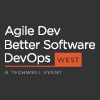Agile Dev West 2018

PRESENTATIONS
|
Managing DevOps Complexity with Systems Thinking
Many teams make the mistake of starting their DevOps journey without a plan. They are excited that there is a way to eliminate pain and increase value in their delivery cycles and value streams, but starting without a plan often relieves pain in one part of the value stream but only causes more pain elsewhere. In this case study-style presentation, Logan Daigle will discuss the methods he has used with a variety of companies to ensure they are thinking about the whole DevOps picture from the beginning. |

Logan Daigle |
|
Managing Microservices Using Terraform, Docker, and the Cloud
Much has been written about how to write microservices, but not enough about how to effectively deploy and manage them. Microservices architecture multiplies the number of deployables IT has to manage by at least ten. In that world, tooling to manage cloud deployments and related infrastructure has become essential for success, and Terraform and Docker are increasingly being leveraged to facilitate microservices environments. |

Derek Ashmore |
|
Measuring Flow: Metrics That Matter
Are you considering kanban but not sure how you’ll predict delivery without story points, velocity, and a burndown chart? Or are you part of a Scrum team but feeling like your team could benefit from improved flow within your sprints? In this session, join Julie Wyman and Hunter Tammaro as they explore key kanban metrics for measuring team flow and predictability. In the first half, they will introduce metrics including lead and cycle time, throughput, and the cumulative flow diagram. |

Julie Wyman |
|
Methods for Handling Key-Person Dependencies in Agile Teams
On any team, from infrastructure engineering to development to HR, there is always a looming danger of one individual being the only person capable of performing a key task, either because of their technical skills, domain skills, or business experience. The risks of having key-person dependencies—reduced productivity, inaccurate project estimates, morale problems, delays, and business-impacting defects and downtime—are hard to identify and can be even harder to resolve. |
Lee Eason |
|
Mobbing for Test Design: Connecting with Your Colleagues’ Test Ideas
[video:https://youtu.be/egHJPdubNss width:300 height:200 align:right] |

James Fogarty |
|
Outcome Over Output: Don't Be a Backlog Lumberjack
As agile goes mainstream, many organizations are only focused on mastering different elements of agile frameworks. Progress is measured by vanity metrics such as velocity and burndown charts. These metrics can turn agile teams into backlog lumberjacks! Teams, ScrumMasters, and leadership must realize that while speed to launch is crucial to delivering software, speed to learning is even more important. |

Kalpesh Shah |
|
Overcoming Test-Driven Damage
Test-driven development is supposed to help us refactor our code safely, but we often find that when we refactor our code, we also have to refactor our tests. What was supposed to add safety becomes a burden requiring time and effort. Writing good unit tests is a critical skill that developers need to master in order to get the most benefit from test-driven development. Tests must be unique, written at the right level of abstraction, and implementation-independent in order to be most valuable. |
David Bernstein |
|
Peer to Peer Session: Solving Your Continuous Delivery Problems
Peer-to-peer Discussion: How Do I Make CD Work in My Environment? Building a successful continuous delivery pipeline is very context specific. Large organizations with legacy code, existing physical environments, regulatory constraints, large monolithic applications, or stove piped organizations often struggle to find a continuous delivery approach that will work for them successfully. If this sounds familiar, this session is for you. |
Lee Eason |
|
Product Delivery Powered by Continuous Integration: A Case Study
Are you a developer who wants to easily manage and customize continuous integration and delivery? Do you work in a team environment where everyone collaborates and depends on CI for automation and delivery of clean code to production? In this session, Amit Mishra will share a case study of how Credit Karma evolved from a single, standalone CI instance to a self-service, Dockerized CI infrastructure combined with bots, webhooks, and GitHub APIs. |

Amit Mishra |
|
Proving Out Your DevOps Pipeline Using a Minimum Viable Product
In the rush to be more competitive, an organization is often tempted to do an across-the board, "big bang" implementation. However, taking a big bang approach to implementing a DevOps pipeline carries with it a myriad of risks and challenges that can result in a failed DevOps implementation. Many of these risks and challenges can be mitigated or even eliminated by developing a DevOps minimum viable product (MVP). Join Tim Guay as he discusses how to apply an MVP concept to DevOps. |

Tim Guay |


